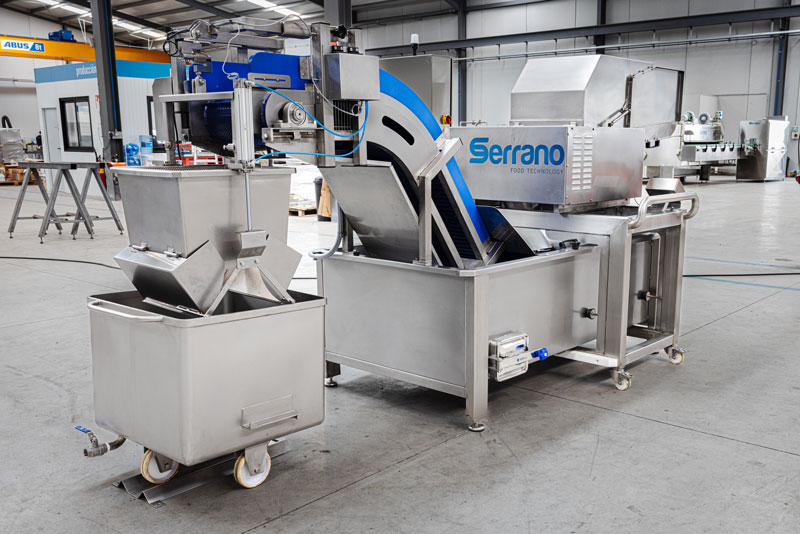In the food industry, the market is changing faster than ever. New consumer trends, smaller formats, healthier recipes, on-the-go options, plant-based products… Every innovation presents a challenge for production plants, which must be able to adapt without slowing production or blowing the budget.
The problem is well-known: many lines are designed to manufacture a single product or product family. When the need arises to launch a variant or incorporate a new size, the traditional solution usually involves acquiring an additional machine or reorganizing entire processes. The result: high investments, long installation times, and downtime that is difficult to manage.
But there is an increasingly widespread alternative among the most competitive manufacturers in the sector: modular machinery. This solution allows production lines to be adapted to new products quickly, scalably, and without large investments.
What is modular machinery and why is it transforming production lines?
Modular machinery consists of independent modules that can be combined, interchanged, or expanded according to process needs. Instead of purchasing a fixed machine for a single function, the user can:
- Add a module when a new product is introduced.
- Replace a specific station (dosing, conveying, inspection) without modifying the rest of the line.
- Reconfigure the line in minutes to adapt it to a different format or recipe.
- Scale capacity by adding stages or increasing speed as demand grows.
Ultimately, modularity transforms a production line into an evolving system, capable of being updated just like software.
Modularity is not just a trend: it is a sustainable growth strategy for any food manufacturer looking to compete in dynamic markets.
The real challenge: adapting to the market without increasing capital expenditure
The pressure to innovate continues to grow. Food manufacturers need to:
- Launch new products with faster development cycles.
- Work with smaller batches and greater variety.
- Change formats frequently to meet retail expectations.
- Reduce downtime between products.
All this without sacrificing efficiency, increasing production costs, or making massive investments every time a new market opportunity arises. Modular machinery precisely addresses this challenge: it allows for increased plant flexibility without multiplying the initial investment.

Main advantages of implementing modular machinery in the food industry
1. Quick and easy format changes
Modular lines are designed so that operators can switch between products with minimal downtime.
Features that make it possible:
- Tool-free adjustments.
- Interchangeable components designed for different sizes.
- Pre-configured programs accessible from the control panel.
- Plug-and-play stations that connect and disconnect easily.
Result: The plant can continue operating without major production interruptions. This allows for working with a greater variety of products, even in short runs, while maintaining high efficiency.
2. Immediate adaptation to new sizes, formats, or recipes
Modularity facilitates, among other things, changes in:
- Ingredient or dough dosing.
- Cutting systems for new thicknesses or shapes.
- Mixing or kneading equipment for different formulations.
- Conveyors for trays, bags, cartons, or flow packs.
- Inspection stations with cameras or X-rays, depending on the type of product.
- Coating systems (glazing, greasing, sprinkling, topping).
Instead of investing in a new machine for each variant, it is enough to change or add modules.
3. Significant reduction in capital expenditure
Modularity reduces investment in two ways:
A) No need to replace the entire line
When a new product is launched, a complete overhaul isn’t necessary: only the required modules are added.
B. Expansions can be done in phases
The client can start with a basic line and expand it as the market demands, avoiding upfront investment.
4. Longer lifespan and less obsolescence
Modular lines are designed as an open ecosystem. When new technologies emerge (improved inspections, increased dosing capacity, more precise vision systems), they can be integrated without replacing the entire machine. This extends the equipment’s lifespan and keeps the plant up-to-date at a lower cost.
5. Operational efficiency and fewer stoppages
Thanks to the standardization of parts and modules, direct benefits are obtained:
- Reduced maintenance time.
- Fewer specific spare parts.
- Simpler operator training.
- Reduced unplanned downtime.
For those in charge of production, this translates into stability, performance, and safety.
Is modular machinery right for your plant?
The answer is almost always yes, especially if your company:
- Launch new products or recipes on a recurring basis.
- Operate with different packaging formats.
- Need to reduce changeover times between batches.
- Seek to increase capacity without major capital investments.
- Want to keep their line up-to-date without renewing it every few years.
- Want to reduce operating costs and increase flexibility.
Modular machinery doesn’t just give you flexibility: it gives you the freedom to innovate without fear of cost. If your plant needs to adapt quickly to new market trends, reduce investments, and maintain agile production, a modular solution is the best way to grow today and tomorrow.
